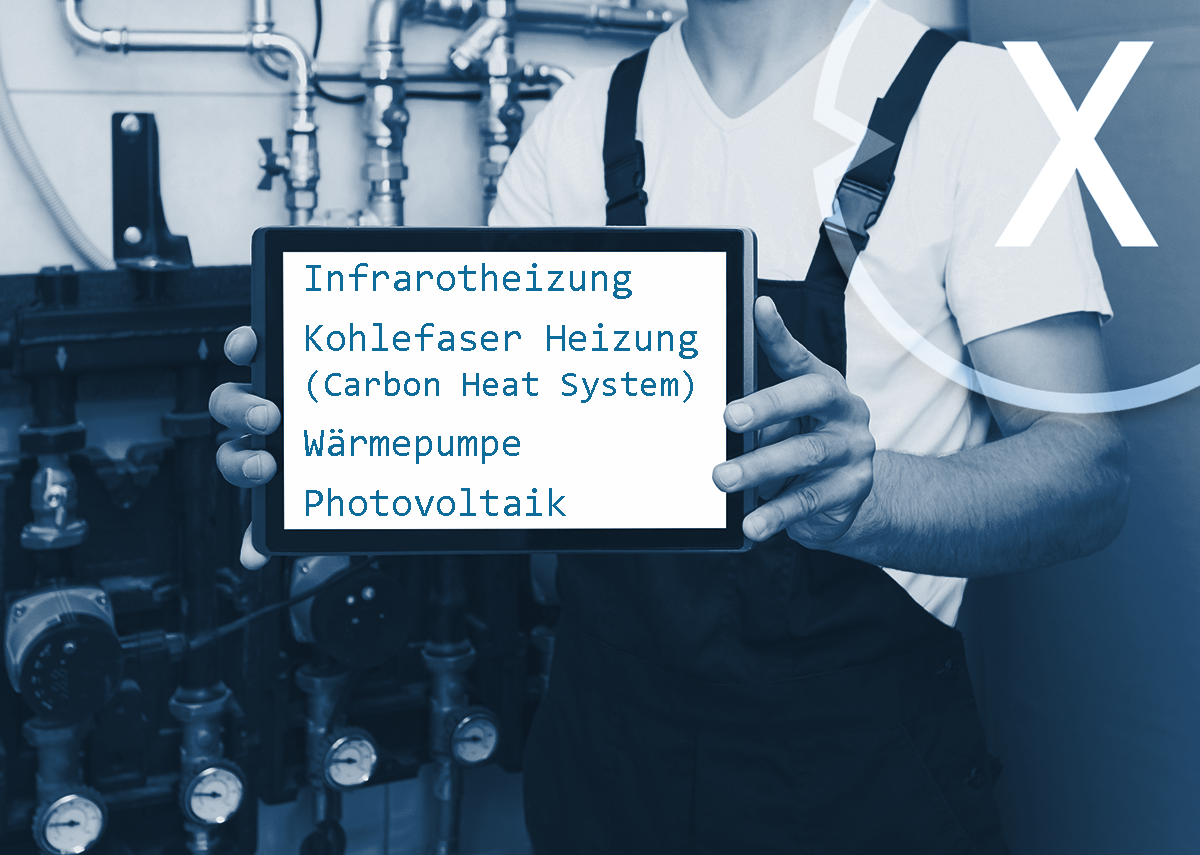
Heating systems of the future. Carbon fiber heaters and heat pumps in combination with photovoltaics – Image: Xpert.Digital
Sustainable heating systems
Sustainable heating systems are increasingly relying on a combination of carbon fiber heaters (infrared) and/or heat pumps, which, in conjunction with photovoltaics, offer an efficient and sustainable solution.
Carbon fiber heaters use innovative technology that uses carbon fiber elements as heating elements. These heat up quickly and emit infrared rays, which ensure a comfortable warmth in the room. Their efficiency and targeted heat emission make them a promising option for heating rooms.
In combination with heat pumps, the efficiency of the heating system is further increased. Heat pumps use the ambient heat, for example from the air, the ground or groundwater, to generate heat. By using heat pumps, less primary energy is required because the existing environmental energy is used.
The integration of photovoltaics into this heating system enables a sustainable and self-sufficient energy supply. The photovoltaic systems installed on the roof or on the facade generate electricity from solar energy. This electricity can be used to operate the heat pumps as well as for other electrical consumers in the household. By using renewable energies, CO2 emissions are reduced and the ecological footprint is reduced.
The combination of carbon fiber heaters, heat pumps and photovoltaics offers numerous advantages. In addition to energy efficiency and sustainability, it also enables greater independence from fossil fuels and rising energy costs. In addition, modern heating systems of this type offer a high level of flexibility and adaptability to different types of homes and buildings.
When planning and installing such a heating system, it is advisable to seek expert advice to ensure optimal sizing, integration and efficiency. The combination of carbon fiber heaters, heat pumps and photovoltaics represents a promising solution to meet the requirements for sustainable and environmentally conscious heating systems.
How do carbon fiber heaters work?
Carbon fiber heaters utilize the specific properties of carbon fiber materials to generate heat. Carbon fiber consists of very thin, light and flexible fibers made from carbon. These fibers have high electrical conductivity and can therefore be used as heating elements.
The heater consists of an array of carbon fiber elements embedded in a flexible material such as plastic or fabric. These elements are supplied with electrical energy through a circuit. When current flows through the carbon fiber, the resistance of the fibers causes heating.
Because carbon fiber is a very efficient material, it converts most of the electrical energy supplied into heat. The heat is then evenly distributed over the surface of the heater. Depending on the design and application, carbon fiber heaters can be arranged either as large area heating elements or in specific patterns to create targeted areas of heat.
An important advantage of carbon fiber heaters is their fast response time. Due to the low mass of carbon fiber, they heat up quickly when electricity is flowing and also cool quickly when the electricity is turned off. This allows precise control of the temperature.
Installation of an infrared carbon heating film for the floor - Image: Xpert.Digital / Dmitry Melnikov|Shutterstock.com
➡️ Installation of an infrared carbon heating film for the floor. Heating foil roll, thermostat and roll for thermal insulation are on the OSB floor (Oriented Strand Board / coarse chipboard) in the room. Electric underfloor heating system as radiant heating.
Carbon fiber heaters find application in various areas such as heated car seats, heated garments, underfloor heating, industrial processes and much more. They offer an efficient and flexible way to generate heat and can be adjusted as needed.
Carbon heater (Carbon Heat)
A carbon heater uses electrical energy to generate heat. It is powered by electricity and emits infrared heat, which creates a pleasantly warm atmosphere in rooms - similar to the warmth of the sun. The different types of carbon fiber heaters offer a particularly versatile solution. Below we explain how a carbon heater works and for whom the technology can be particularly interesting.
A carbon heater consists of special carbon fiber elements that act as heating elements. These elements are heated electrically and then emit infrared rays. These rays do not heat the surrounding air, but rather hit solid surfaces such as walls, floors and furniture, which absorb and release the heat. This creates a comfortable and even heat in the room.
The versatility of carbon heaters lies in the fact that they are available in different shapes and sizes. There are carbon fiber heaters that can be installed as wall panels, ceiling panels or even as underfloor heating. This enables flexible adaptation to individual needs and the architectural conditions of the room.
A carbon heater is particularly suitable for people who need quick and targeted heating. Since the heat is available immediately after switching on and is delivered directly to the surfaces in the room, a pleasant and even warmth is created without the need to circulate or replace the air. This can be particularly beneficial for allergy sufferers, as no air movements trigger allergic reactions.
In addition, carbon heaters are energy efficient and environmentally friendly. The direct radiant heat means no heat loss through air circulation, resulting in efficient use of electrical energy. In addition, there are no harmful emissions or combustion residues because the heating is operated purely electrically.
Overall, a carbon heater offers a modern and effective solution for heating rooms. Their versatility, efficiency and pleasant warmth make them an interesting option for various living and working areas. However, before installation, it is advisable to seek advice from professionals in order to find the optimal solution for your individual needs.
Infrared? By the way, have you heard this before, but haven't asked in more detail? It will be important to understand it in the future
Infrared stands for “below the red” and refers to the part of the electromagnetic spectrum, which is located directly below the visible red light. It is electromagnetic radiation with longer wavelengths as a visible light.
The term “infrared” was first shaped by the German astronomer Sir William Herschel in 1800. In experiments for temperature measurement, Herschel wanted to examine the temperature difference between different colors of the spectrum and carried out a prism attempt. He measures the temperatures with thermometers to determine the difference in the heat output. He discovered that the temperature beyond the red area was higher in the spectrum than in the visible area. Herschel described this invisible radiation as “infrared radiation”.
Research into infrared radiation has since led to numerous applications in various fields, including thermal imaging cameras, remote controls, infrared sensors, infrared radiation heating, and even medical applications such as infrared therapy. Infrared radiation is invisible to the human eye, but it can be detected and measured by special sensors or cameras.
Running heat pumps with solar, does that make sense?
It definitely makes sense to run heat pumps with solar energy. The combination of heat pumps and solar energy can result in an extremely efficient and environmentally friendly heating solution. Here are some reasons why this combination makes sense:
Renewable Energy Source: Solar power is a renewable energy source that is derived from sunlight. By running your heat pump with solar energy, you are using a sustainable energy source and reducing your carbon footprint.
Cost savings: Operating a heat pump can be more cost-effective with solar power than with conventional electricity from the grid. If your solar system generates enough electricity to meet the needs of the heat pump, you can significantly reduce your heating costs.
Optimizing your own consumption: With a solar system you can produce electricity during the day when the sun is shining. This fits well with the operation of most heat pumps, which can produce more heat during the day when electricity demand is higher. By directly using the solar power you generate to power the heat pump, you maximize your own consumption and minimize your electricity consumption from the grid.
Environmental friendliness: The combination of heat pumps and solar power helps reduce fossil fuel consumption and therefore reduces greenhouse gas emissions. This is an important step towards combating climate change and promoting a sustainable future.
However, it is important to note that the effectiveness of this combination depends on various factors, such as the size of the solar system, the performance of the heat pump, the heating requirements of the building and the climatic conditions. Thorough planning and sizing of the system by a professional is recommended to ensure optimal performance and efficiency.
The combination of heat pumps and solar energy represents a promising and environmentally friendly heating solution that offers both financial and environmental benefits.
- Plan photovoltaics for warehouses, commercial halls and industrial halls
- Industrial plant: Plan a photovoltaic open-air system or open-space system
- Plan solar systems with photovoltaic solutions for freight forwarding and contract logistics
- B2B solar systems and photovoltaic solutions & advice
Technical advice from Xpert.Solar – carbon fiber heaters (infrared heating) and heat pumps in combination with solar/photovoltaics
I would be happy to serve as your personal advisor.
You can contact me by filling out the contact form below or simply call me on +49 89 89 674 804 (Munich) .
I'm looking forward to our joint project.
Xpert.Digital – Konrad Wolfenstein
Xpert.Digital is a hub for industry with a focus on digitalization, mechanical engineering, logistics/intralogistics and photovoltaics.
With our 360° business development solution, we support well-known companies from new business to after sales.
Market intelligence, smarketing, marketing automation, content development, PR, mail campaigns, personalized social media and lead nurturing are part of our digital tools.
You can find out more at: www.xpert.digital – www.xpert.solar – www.xpert.plus

